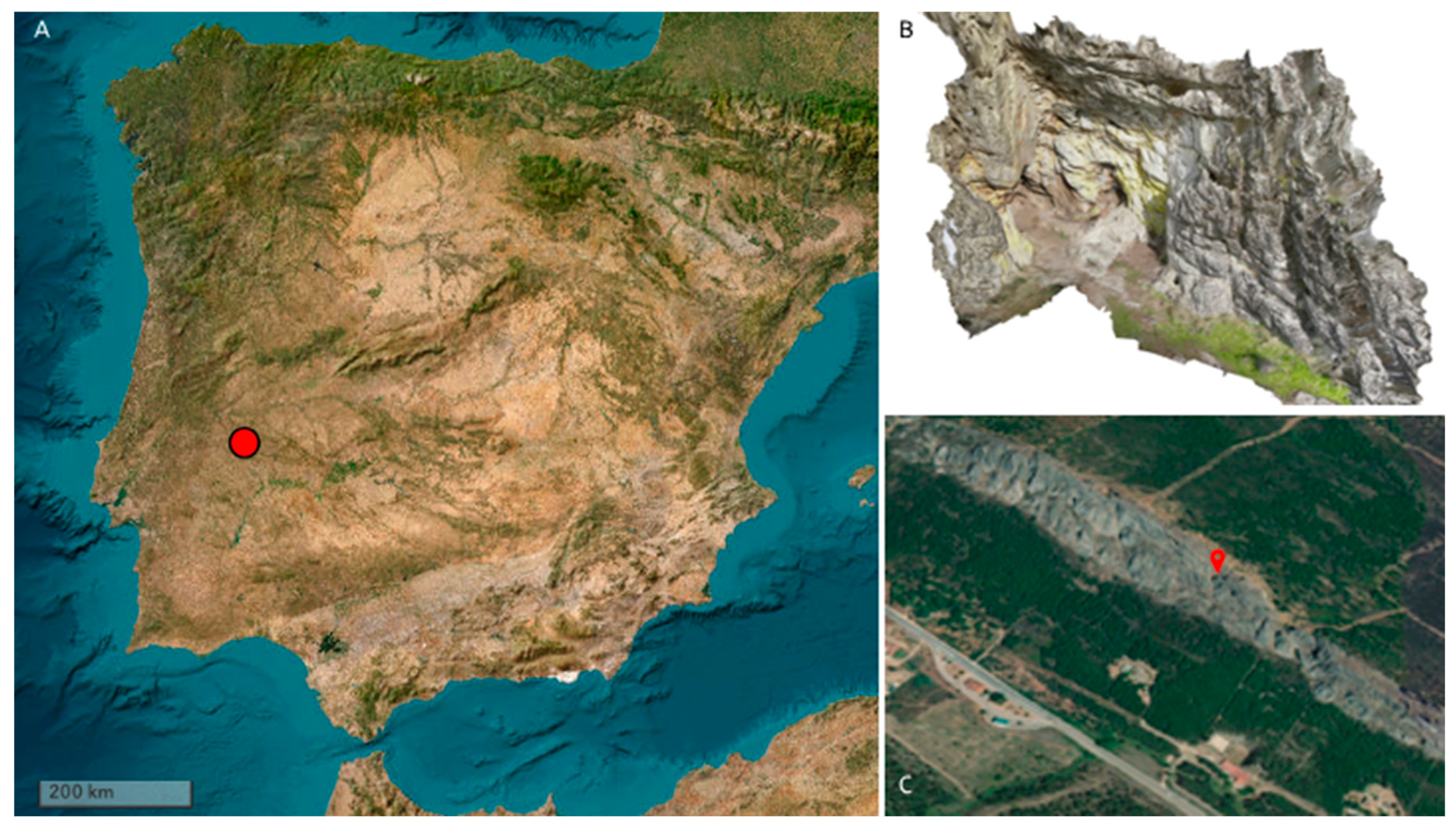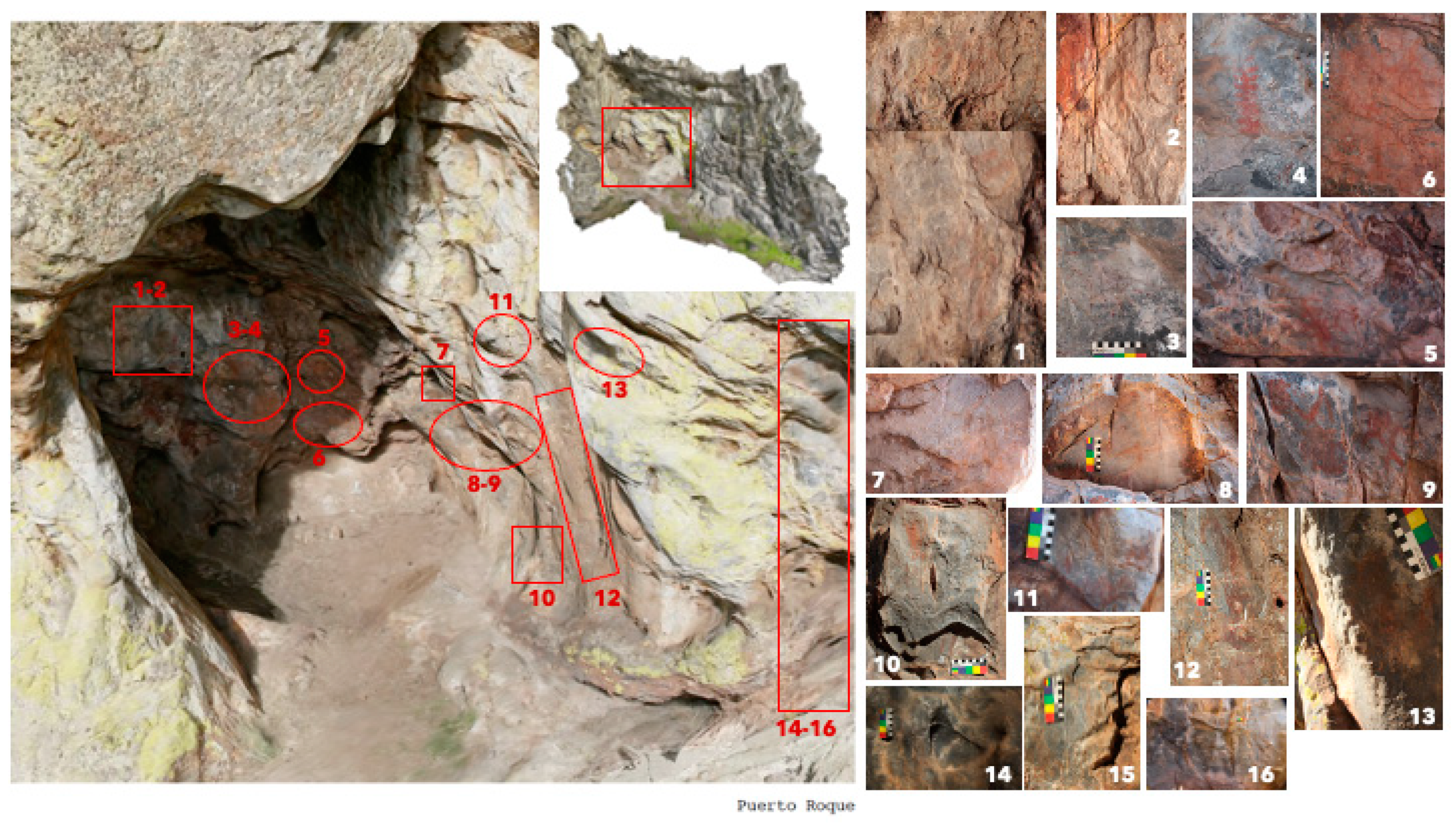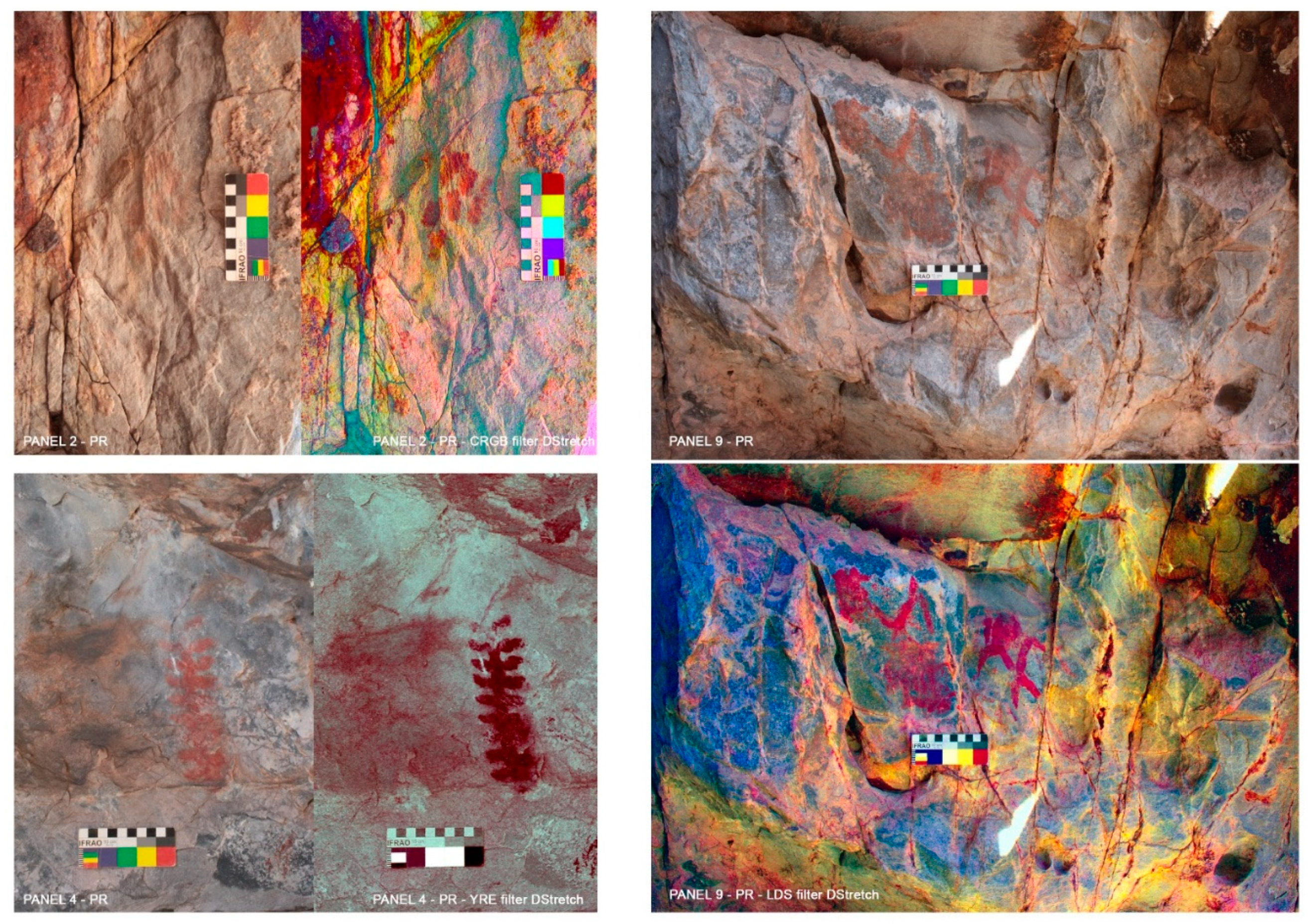Submitted:
12 December 2023
Posted:
13 December 2023
You are already at the latest version
Abstract
Keywords:
1. Introduction

2. Materials and Methods
2.1. Micro-Raman Spectroscopy:
2.2. Fourier-Transform Infrared Spectroscopy (ATR-FTIR):
2.3. Energy-Dispersive X-ray Micro-fluorescence (EDxrf):
2.4. Scanning Electron Microscopy (SEM):
3. Results and Discussion
3.1. Raman Spectra Results:
3.2. Fourier-Transform Infrared Spectroscopy (ATR-FTIR) Results:
3.3. X-ray fluorescence (EDxrf) Results:
3.4. SEM-EDS results:
4. Conclusions
References
- Oliveira, J., Torres, M. F. (2021). O Abrigo do Ninho do Bufo - o painel da parturiente e o seu contexto (Marvão–Portugal). Scientia Antiquitatis 2021 ISSN: 2184-1160 pp. 24- 51.
- González Cordero, A. (1999). Datos para Ia conrextualizaci6n del arte rupestre en Ia Alta Extremadura. Zephyrus, 52: 191-220.
- Rogerio-Candelera, M.A., Vanhaecke, F., Resano, M., Marzo, P., Porca, E., Alloza, R., Saiz-Jimenez, C. (2009). Combinação de análise de imagens e técnicas analíticas para a distinção de diferentes fases num painel rochoso (La Coquinera II, Obón, Teruel). In Actas IV Congreso El Arte Rupestre del Arco Mediterráneo de la Península Ibérica: 327-334. Valência,Generalitat Valenciana.
- Collado Giraldo, H; García Arranz, J.J. (2013). Reflexiones sobre la fase inicial del arte rupestre esquemático en Extremadura a raíz de las recientes investigaciones. In: Actas del II Congreso de Arte Rupestre Esquemático en la Península Ibérica: Comarca de Los Vélez, 5-8 de mayo 2010. 2013. p. 287-299.
- Edwards, H.G.M., Newton, E.M., Russ, J. (2000). Raman spectroscopic analysis of pigments and substrata in prehistoric rock art. Journal of Molecular Structure, 550 (1), p. 245- 256. [CrossRef]
- Hoerlé, S., Bertrand, L., Mguni, S., Jacobson, L., (2010). Microanalysis and Dating for Rock Art Studies: Towards a Common Analytical Strategy. South African Archaeological Bulletin, 65(192), p.221-228.
- Fleming, M.I.A. (2008). Aplicação da arqueometria no estudo de coleções arqueológicas. Revista CPC, São Paulo. 6, p.219-230.
- Resano, M., García-Ruiz, E., Alloza, R., Marzo, M.P., Vandenabeele, P., Vanhaecke, F. (2007). Espectrometria de massa por ablação a laser com plasma indutivamente acoplado para acaracterização de pigmentos em arte rupestre pré-histórica. Analytical Chemistry 79 (23): 8947-8955.
- Lavé, J. (2013). Painted rock art and the archaeology of performance: The Magura Cave, Bulgaria. Journal of Archaeological Method and Theory, 20(3), 446-476.
- Müller, C.M. Pejcic, B. Esteban, L. Piane, C. Raven, M. and Mizaikoff, B., (2014). Infrared Attenuated Total Reflectance Spectroscopy: An Innovative Strategy for Analyzing Mineral Components in Energy Relevant Systems. Sci Rep. 4. 6764. [CrossRef]
- Franquelo, M. L., Perez-Rodriguez, J. L. (2016). A new approach to the determination of the synthetic or natural origin of red pigments through spectroscopic analysis. Spectrochimica Acta - Part A: Molecular and Biomolecular Spectroscopy, 166, 103–111. [CrossRef]
- Huntley, J., Wallis, L. A., Stephenson, B., Davis, A. (2021). A multi-technique approach to contextualizing painted rock art in the Central Pilbara of Western Australia: Integrating in-field and laboratory methods. Quaternary International, 572, 52-73.
- Gomes, H.; Collado, H.; Martins, A.; Nash, G. H.; Rosina, P.; Vaccaro, C.; Volpe, L. (2015a). Pigment in western Iberian schematic rock art: An analytical approach. Mediterranean Archaeology and Archaeometry, , 15(1), 163–175. [CrossRef]
- Rosina, P.; Gomes, H.; Collado, H.; Nicoli, M.; Volpe, L.; Vaccaro, C. (2018). Μicro-Raman spectroscopy for the characterization of rock-art pigments from Abrigo del Águila (Badajoz – Spain). Optics and Laser Technology, 102, 274–281. [CrossRef]
- Rosina, P.; Collado, H.; Garcês, S.; Gomes, H.; Eftekhari, N.; Nicoli, M.; Vaccaro, C. (2019). Benquerencia (La Serena - Spain) rock art: An integrated spectroscopy analysis with FTIR and Raman. Heliyon, 5(10), e02561. [CrossRef]
- Garcês, S.; Collado, H.; Rosina, P.; Gomes, H.; Nash, G.; Nicoli, M.; (2022). Vaccaro, C. Identification of organic material in Los Buitres 1 rock art shelter, Badajoz, Spain. Complutum, , 33 (2): 347-361. [CrossRef]
- Nicoli, M.; Eftekhari, N.; Vaccaro, C.; Collado Giraldo, H.; Garcês, S.; Gomes, H.; Lattao, V.; Rosina, P. (2023). A multi-analytical evaluation of the depositional pattern on open-air rock art panels at “Abrigo del Lince” (Badajoz, Spain). Environmental Science and Pollution Research, 30(9), 24344-24360. [CrossRef]
- Hernanz, A.; Mas, M.; Gavilán, B.; Hernández, B. (2006). Raman microscopy and IR spectroscopy of prehistoric paintings from Los Murciélagos cave (Zuheros, Córdoba, Spain). Journal of Raman Spectroscopy, 37. p.492–497.
- Hernanz, A.; Ruiz-López, J.; Gavira Vallejo, J. M. (2010). Pigmentos, aglutinantes y pátinas: Caracterización fisicoquímica de la tecnología de las pinturas rupestres levantinas. IN: García Arranz, J. J.; Collado Giraldo, H.; Nash, G. (Eds.) The Levantine Question. Post-Paleolithic rock art in the Iberian Peninsula, pp. 345-365. [CrossRef]
- Hernanz, A.; Gavira-Vallejo, J.M.; Ruiz-López, J.F.; Martin S.; Maroto-Valiente, Á.; Balbín-Behrmann R.; Menédez M.; Alcolea-González J.J.; (2012). Spectroscopy of Palaeolithic rock paintings from the Tito Bustillo and El Buxu Caves, Asturias, Spain. Journal of Raman Spectroscopy, 43. p.1644–1650. [CrossRef]
- Baldellou, V.; Alloza, R. (2012). El análisis de pigmentos en Aragón: otra forma de documentar el arte rupestre. Jornadas Técnicas para la gestión del arte rupestre, Património Mundial. Parque Cultural del Río Vero, Alquézar - Huesca. Comarca de Somontano de Barbaste, 28 a 31 Mayo, pp. 73-83.
- Iriarte, M.; Hernan, A.; Ruiz-López, J.; Martin, S. (2013). Raman Spectroscopy of Prehistoric Paintings From The Abrigo Remacha Rock Shelter (Villaseca, Segovia, Spain). Journal of Raman Spectroscopy, 44:1557-1562. [CrossRef]
- Mas, M., Jorge, A., Gavilán, B., Solís, M., Parra, E., & Pérez, P. P. (2013). Minateda Rock Shelters (Albacete) And Post-Palaeolithic Art of the Mediterranean Basin in Spain: pigments, surfaces and patinas. Journal of Archaeological Science, 40: 4635-4647. [CrossRef]
- López-Montalvo E.; Roldán C.; Badal E.; Murcia-Mascarós S.; Villaverde V. (2017). Identification of plant cells in black pigments of prehistoric Spanish Levantine rock art by means of a multi-analytical approach. A new method for social identity materialisation using chaîne opératoire. PLoS ONE, 12(2): e0172225. [CrossRef]
- Thomas, A. (1980). Colours from the Earth. New York: Van Nostrand Reinhold.
- Fuller, C. (1988). Natural Colored Iron Oxide Pigments. In: Lewis P. (Ed.). Pigment Handbook, 2nd Edition. New York. John Wiley Sons. p.281-286.
- Menu, M., Walter, P., (1996). Matières picturales et techniques de peinture. In: Brunet, J., Vouvé, J., (Eds.), La Conservation des Grottes Ornées. CNRS, París, p. 31-41.
- Elias, M., Chartier, C., Prévot, G., Garay, H., Vignaud, C., (2006). The colour of ochres explained by their composition. Materials Science and Engineering B. 127, p. 70-80. [CrossRef]
- Hodgskiss, T., (2010). Identifying grinding, scoring, and rubbing use-wear on experimental ochre pieces. Journal of Archaeological Science 37 (12), p.3344-3358. [CrossRef]
- Gialanella, S., Belli, R., Dalmeri, G., Lonardelli, I., Mattarelli, M., Montagna M., Toniutti, L., (2011). Artificial or natural origin of hematite-based red pigments. Archaeometry 53, (5), p.950-962.
- Martí Oliver, B.; Hernandez Perez, M. S (1988). El Neolític Valencià. Arte Rupestre i cultura material. Serie d’Investigació Prehistórica de la Diputación de Valencià, 116p.
- Carrasco Rus, J.; Navarrete Enciso, M. S.; Pachón Romero, J.A. (2005). Nuevos datos para el estudio de representaciones zoomorfas en el arte esquemático de Andalucía. Revista Tabona.. 13: 41-54.
- A.I.C.- American Institute for Conservation (2023). - Code of Ethics and Guidelines for Practice. AIC- www.conservationus.org (access in 2023).
- Huntley, J., Westaway, K. E., Gore, D. B., Aubert, M., Ross, J., Morwood, M. J. (2016). Non-Destructive or Noninvasive? The Potential Effect of X-Ray Fluorescence Spectrometers on Luminescence Age Estimates of Archaeological Samples. Geoarchaeology, 31(6), 592-602. [CrossRef]
- Horn, K. R., Walker, G., Winton, V., Ramanaidou, E., Hamlett, C., & Hamlett, B. (2020). Field characterization of rock art paintings using non-invasive reflectance spectroscopy in the search for organic paint binders at Genealogy and Stickman Rock-shelters in the Weld Range (Western Australia). Journal of Archaeological Science: Reports, 34(November), 102617.
- Wainright, I.N.M; Helwig, K.; Rolandi, D.S.; Gradin, C.; Podestá, M.M.; Onetto, M.; Achero, C.A. (2002). Rock Paintings Conservation and Pigment Analysis at Cueva de las Manos and Cerro de los Indios, Santa Cruz (Patagonia), in: R. Vontobel (ed), ICOM Committee for Conservation, 13th Triennial Meeting, Rio de Janeiro, 22–27 September 2002, James and James. Science Publishers. 2002 London, p.582-589.
- Castellucci E. M., Perardi A., Zoppi A. (1999). La Spettroscopia Micro-Raman E Le Sue Applicazioni/Micro-Raman Spectroscopy and Its Applications. OPD restauro, (11): 16-29.
- Burgio, L., Clark, R.J.H., (2001). Library of FT-Raman spectra of pigments, minerals, pigment media and varnishes, and supplement to existing library of Raman spectra of pigments with visible excitation. Acta Spectrochimica Part A. 57, p.1491-1521. [CrossRef]
- Vandenabeele, P. Edwards, H.G.M. Moens, L., (2007). A Decade of Raman Spectroscopy in Art andArchaeology. Chem. Rev. 107. p.675–686.
- Buzgar, N., Apopei A.I., (2009). The Raman study on certain carbonates. Analele Scintifice ale Universitatii “Al. I. Cuza” Iasi. 55 (2), p.97-112.
- Lebon, M., Beck, L., Lahli, S., Rousselière, H., Castaing, J., Durán, A., (2011). “Étude de parois ornées par analyses in situ. Apports, limites et potentiel des techniques de DRX-XRF, m-Raman portables: l’exemple de Rouffignac”, MADAPCA-2011.
- Caggiani, M. C., Cosentino, A., & Mangone, A. (2016). Pigments Checker version 3.0, a handy set for conservation scientists: A free online Raman spectra database. Microchemical Journal, 129, 123-132. [CrossRef]
- Prinsloo, L.C., Tournié, A., Colomban, P., Paris, C., Bassett, S.T. (2013). In search of the optimum Raman/IR signatures of potential ingredients used in San/Bushman rock art paint. Journal of Archaeological Science, 40, p. 2981-2990. [CrossRef]
- Bhargava, R., Wang, S. Q., Koenig, J. L. (2003). FTIR microspectroscopy of polymeric systems. Advances in Polymer Science, 163: 137–191.tir. [CrossRef]
- Prinsloo L. C., Wadley L., Lombard M. (2014). Infrared reflectance spectroscopy as an analytical technique for the study of residues on stone tools: Potential and challenges. Journal of Archaeological Science, 41: 732–739. [CrossRef]
- Mauser, K.E., Mueller, L. (1985). Detection limits in x-ray fluorescence analysis. Second international symposium on analytical chemistry in the exploration, mining and processing of materials, (p. 348). South Africa.
- Clark, R.J.H., Curri, M.L., (1998). The identification by Raman Microscopy and X-ray diffraction of iron oxide pigments and of the red pigments found on Italian pottery fragments. Journal of Molecular Structure (440), p.105–111. [CrossRef]
- Börjesson, J., Mattsson, S., Mori, Y., Zucchiatti, A., Ninomiya, T., Szalóki, I., Osán, J., de Hoog, J. & Van Grieken, R. (2004). New Applications. X-Ray Spectrometry: Recent Technological Advances, 487-592.
- Verma, H. R. (2007). X-ray fluorescence (XRF) and particle-induced X-ray emission (PIXE). Atomic and Nuclear Analytical Methods: XRF, Mössbauer, XPS, NAA and B63Ion-Beam Spectroscopic Techniques, 1-90.
- Roldán, C., Murcia-Mascarós, S., Ferrero, J., Villaverde, V. Martínez, R., Guillem, P., (2010). Application of field portable EDXRF spectrometry to analysis of pigments of Levantine rock art. X- Ray Spectrometry. 39(3), p.243-250. [CrossRef]
- Josa, V. G., Bertolino, S. R., Laguens, A., Riveros, J. A., Castellano, G. (2010). X-ray and scanning electron microscopy archaeometric studies of pigments from the Aguada culture, Argentina. Microchemical Journal, 96(2), 259-268. [CrossRef]
- Eastaugh, N.; Walsh, V.; Chaplin, T.; Siddall, R. (2008). Pigment compendium. A dictionary and optical microscopy of historical pigments, Elsevier Butterworth-Heinemann, Oxford, UK.
- Lofrumento, C. Ricci, M. Bachechi, L. De Feo, D. Castellucci, E.M., (2012). The first spectroscopic analysis of Ethiopian prehistoric rock painting. J. Raman Spectrosc. 43. p.809–816.
- Faria, D.L.A., Lopes, F.N., (2007). Heated goethite and natural Haematite: can Raman spectroscopy be used to differentiate them? Vibrational Spectroscopy 45.p.117–121.
- Frost, R.L., (2004). Raman spectroscopy of natural oxalates. Analytica Chimica Acta, 517 (1- 2), p.207-214. [CrossRef]
- Pavia, D.L., Lampman, G.M., Kritz, G., Engel, R.G., (2006). Introduction to Organic Laboratory Techniques (4th Ed.) Thomson Brooks/Cole, p.797- 817.
- Carvalho, E., et al. (2020). Weathering processes and rock art preservation: The case of an open-air site in NE Iberia. Journal of Cultural Heritage, 45, 128-137.
- Frost, R.L., Ding, Z., Ruan, H.D., (2003). Thermal analysis of goethite. Relevance to Australian indigenous art. Journal Thermal Anal Calorimetry. 71, p.783-797.
- Madejova, J. (2003). FTIR Techniques in Clay Mineral Studies. Vibrational Spectroscopy 31, 1-10. [CrossRef]
- Garcês, S.; Gomes, H.; Haddad, L.; Cura, P.; Rosina, P. (2019). In search of the ATR-FTIR signatures of experimentally mixed ingredients presumably used in prehistoric rock art. Rock Art Research, , 36(2), 182–188.
- Nuevo, M., Sánchez, A. Oliveira, C. Oliveira, J. (2012). In situ energy dispersive X-ray fluorescence analysis of rock art pigments from the ‘Abrigo dos Gaivões’ and ‘Igreja dos Mouros’ caves (Portugal). X-Ray Spectrometry. 41. [CrossRef]
- Bikiaris, D.: Daniilia, S.; Sotiropoulou, S.; Katsimbiri, O.; Pavlidou, E.; Moutsatsou, A.P.; Chryssoulakis, Y.. (2000). Ochre-differentiation through micro-Raman and micro-FTIR spectroscopies: application on wall paintings at Meteora and Mount Athos, Greece. Spectrochim, Acta A. 56. p.3-18. [CrossRef]
- Livingston, A., Robinson, E., Armitage R.A., (2009). Characterizing the binders in rock paintings by THM-GC–MS: La Casa de Las Golondrinas, Guatemala, a cautionary tale for radiocarbon dating. International J. of Mass Spectrometry 284, p.142-151.
- Pozo-Antonio, J. S.; Rivas, T.; Carrera, F.; García, L. (2018). Deterioration processes affecting prehistoric rock art engravings in granite in NW Spain. Earth Surface Processes and Landforms, 43(11), 2435-2448. [CrossRef]
- Hradil, D., Grygar, T., Hradilova J. and Bezdic P. (2003). Clay and iron oxide pigments in the history of painting. Clay Science, 22, p. 223- 236. [CrossRef]
- Dayet, L. (2021). Invasive and non-invasive analyses of ochre and iron-based pigment raw materials: A methodological perspective. Minerals 11(2), 210. [CrossRef]
- Oliveira, C., A. M. S. Bettencourt, A. Araújo, L. Gonçalves, I. Kuźniarska-Biernacka and A. L. Costa (2017). Integrated analytical techniques for the study of colouring materials from two megalithic barrows. Archaeometry 59(6): 1065–1081. [CrossRef]
- Oliveira, C., A. M. S. Bettencourt, L. Gonçalves, M.I.C. Alves, A. Ribeiro, A. Barbosa, M. Martín-Seijo, J. Ribeiro, J. Guedes, C. Delerue-Matos. (2019). A multi-analytical study of rock paintings from Leandro 5 Megalithic barrow, North-Western Portugal. Rock Art Research 36(2):164-172.
- Pomiès, M.P., Menu, M., (1999a). Red palaeolithic pigments: natural hematite or heated goethite? Archaeometry 41 (2), p.275-285.
- Gomes, H.; Rosina, P.; Collado Giraldo, H.; García Arranz, J. J.; Da Silva Nobre, L. F.; Domínguez García, I. M.; Rivera Rubio, E.; Rodríguez Dorado, L.;Torrado Cárdeno, J. M.; Villalba de Alvarado, M.; Nacarino de los Santos, M. (2015). Archaeometric characterization analyses on rock art pigments and natural concretions at Friso del Terror-Monfragüe National Park, Cáceres, Spain. Sobre Rocas y Huesos: Las Sociedades Prehistóricas y Sus Manifestaciones Plásticas, 411–423.
- Ospitali, F., Smith, D.C., Lorblanchet, M., (2006). Preliminary investigations by Raman microscopy of prehistoric pigments in the wall-painted cave at Roucadour, Quercy, France. J. Raman Spectrosc. 37, p.1063-1071.
- Milazzo, M., & Ludwig, N. (2010). Misurare l’arte. Analisi scientifiche per lo studio dei beni culturali, Milano.
- Wreschner, E.E. (1980). Red Ochre and Human Evolution: A Case for Discussion. Current Anthropology 21, p. 631-644. [CrossRef]
- Pomiès, M.P., Barbaza, M., Menu, M., Vignaud, C., (1999b). Préparation des pigments rouges préhistoriques par chauffage. L’Anthropologie 103(4), p. 503-518.


| Sample | Scientific inquiry | EDxrf | Micro-Raman | SEM-EDS | ATR-FTIR |
|---|---|---|---|---|---|
| Puerto_01 | Digit painting directly on the panel (Technique 1) | Ca, Fe | Hematite | -------- | Heated Clay |
| Puerto_02 | Less visible digit paintings (different chronology or erosion issues?) | --- | ----- | -------- | -------- |
| Puerto_03 | Dark red pigment - linear figures made with brush? (Technique 2) | Fe, Si | Hematite | -------- | Heated Clay |
| Puerto_04 | Very visible plant motif (non-geometric figure) (different purpose?) | Ca, Fe | Hematite, Carbon black, red ochre | -------- | --- |
| Puerto_05 | Accumulation of pigment next to very visible human figures | Si, Fe, Ca, Sr | Hematite | -------- | Heated Clay |
| Puerto_06 | Superimpositions (mixture of pigments?) | Ca, Fe | Hematite | -------- | --- |
| Puerto_07 | Figure with a high level of erosion and encrustations on top | Fe, Ca | Hematite | -------- | Hematite, Quartz, and Incrustations |
| Puerto_08 | Pastier texture and different hue | Ca, Fe | Goethite and Hematite | -------- | Quartz (Substrate) |
| Puerto_09 | Superimpositions and good visibility of pigments (different quality?) | Fe, Si | Hematite | -------- | Quartz + Hematite |
| Puerto_10 | Sun-impacted orange figures. Different hues (erosion or on purpose)? | --- | Hematite | -------- | --- |
| Puerto_11 | Difficult to visualise (erosion or different technique?) | Ca, Fe | Hematite | -------- | Clay |
| Puerto_12 | Usage of fingers and splashing pigment (mixture of techniques?) | Fe, Si also Al, K, and P | Hematite | Fe, Al, K, P, Ca | --- |
| Puerto_13 | Faded figure that is difficult to see (erosion or on purpose)? | Ca, Fe, Si | --- | -------- | Quartz (Substrate) |
| Puerto_14 | Linear figures made from small dots (brush tool?) | Fe, Ca | Hematite, Iron oxide (Magnetite) | -------- | Quartz + Hematite |
| Puerto_15 | Blurred orange figures (erosion or antiquity?) | Fe, Si | Hematite | -------- | --- |
| Puerto_16 | Small, hard-to-see red dots (Technique 3) | Ca, Fe, Si | Hematite | -------- | Quartz + Hematite |
| Puerto_17 | Local raw material | Fe, Ca | Goethite | -------- | Goethite |
| Puerto_18 | Local raw material | Fe, Ca | Hematite | -------- | Red Earth (Brown Ochre) |
| Puerto_19 | Local raw material | Fe, Ca | Goethite and Hematite | -------- | Goethite |
Disclaimer/Publisher’s Note: The statements, opinions and data contained in all publications are solely those of the individual author(s) and contributor(s) and not of MDPI and/or the editor(s). MDPI and/or the editor(s) disclaim responsibility for any injury to people or property resulting from any ideas, methods, instructions or products referred to in the content. |
© 2023 by the authors. Licensee MDPI, Basel, Switzerland. This article is an open access article distributed under the terms and conditions of the Creative Commons Attribution (CC BY) license (http://creativecommons.org/licenses/by/4.0/).





